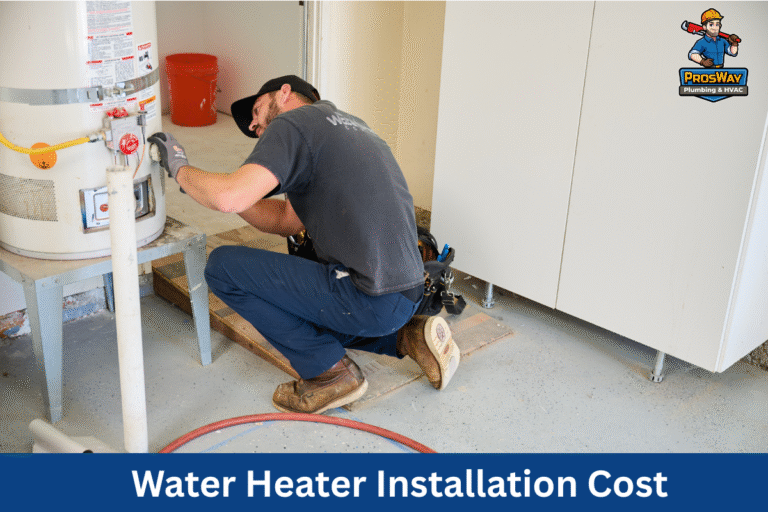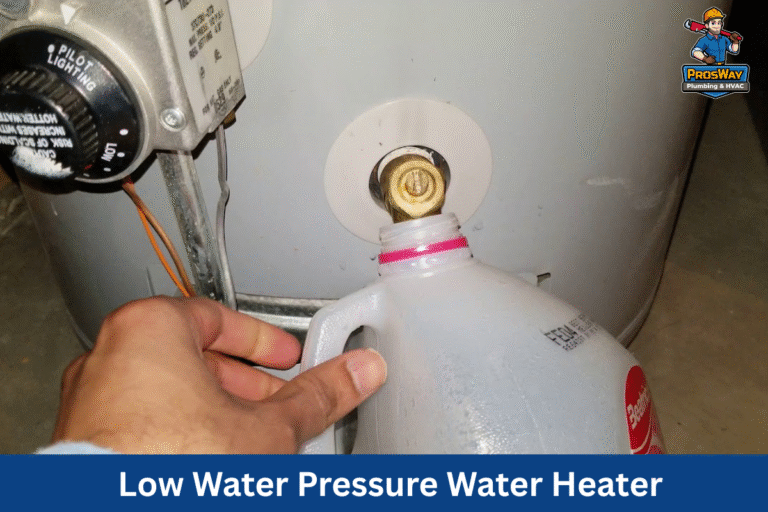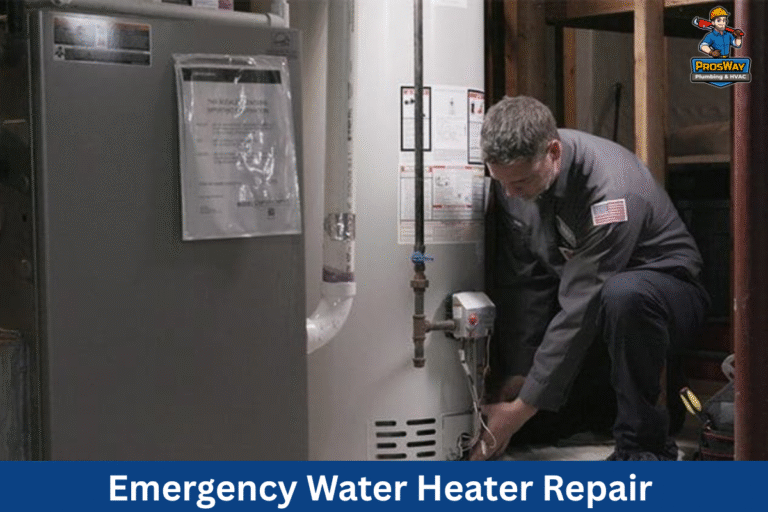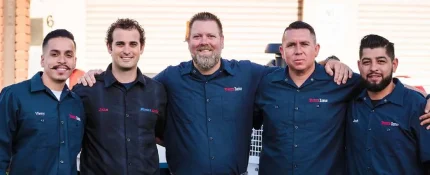At ProsWay Plumbing & HVAC, we understand that sewer line issues can be daunting for homeowners. That’s why we offer trenchless sewer repair as a modern, efficient solution that minimizes disruption to your property.
Unlike traditional methods that require extensive digging, trenchless technology allows us to repair or replace sewer lines with minimal excavation, preserving your landscaping and hardscaping.
In this article, we’ll explore the benefits of trenchless sewer repair, how it compares to traditional methods, and why it’s an excellent choice for maintaining the integrity of your home’s plumbing system.
Key Takeaways
- Trenchless sewer repair minimizes landscape damage while maintaining home aesthetics.
- Techniques such as CIPP, pipe bursting, and slip lining provide durable, long-term solutions.
- Cost savings and reduced project timelines are significant benefits over conventional methods.
- Environmental impact is minimized because less soil disturbance and waste are produced.
- Homeowners in Northern New Jersey can enjoy increased property value and lower maintenance needs by choosing trenchless repair.
- Always verify contractor credentials, warranty details, and case studies before proceeding with your project.
Why Should Homeowners Choose Trenchless Sewer Repair?
Trenchless sewer repair minimizes the hassle and costs associated with traditional digging methods. The first advantage is that it limits damage to your surrounding landscape. When installing or repairing sewer lines using trenchless technology, contractors do not need to excavate large portions of your yard.
This means that your lawn, driveway, and sidewalks remain mostly intact, avoiding the high restoration costs and prolonged inconvenience seen with conventional digging. Additionally, minimizing pressure on surrounding structures reduces the risk of collateral damage.
Another benefit is the efficiency of the repair process. Trenchless repairs can typically be completed much faster than traditional methods, which is crucial when your home’s drainage system is compromised. Faster project timelines reduce the time your family needs to live through construction disruptions.
What Makes Trenchless Sewer Repair Environmentally Friendly?
Trenchless sewer repair is also well-known for its environmentally friendly process. Because this method uses less soil disturbance and produces less waste, it aligns with the increasing demand for sustainable home improvement solutions.
The technology involved is designed to last for decades, meaning you experience fewer emergencies and lower long-term sewer line maintenance costs. This longevity is achieved through advanced materials like resin and polyethylene coatings that reinforce the interior of existing pipes.
Moreover, trenchless repair helps maintain the structural integrity of your plumbing system. Chemical reactions and age can cause pipe deterioration, leading to leaks and sewer line damage. The repair methods used, such as CIPP, provide a smooth interior coating.
Homeowners can rest assured that their sewer line repairs will continue to function efficiently for years to come, reducing the chance of leak detection issues and costly emergency repairs.
The benefits of trenchless sewer repair include minimal landscape disruption, faster project timelines, eco-friendly installation, and enhanced durability of your sewer line.
Why Compare Conventional Sewer Repairs to Trenchless Methods?

Traditional sewer repair techniques often require extensive excavation, resulting in significant damage to your landscaping, sidewalks, and driveways. In a conventional repair, the process involves digging large trenches across your yard and disrupting existing infrastructure like water lines and septic tanks.
In contrast, trenchless solutions preserve your property’s aesthetics and prevent unnecessary damage. This is especially important for homeowners who have invested in professional landscaping or who live in areas with strict property appearance regulations.
Cost and Property Impacts of Each Method
When comparing cost structures, conventional methods entail higher total expenses. The process of digging, restoring landscaping, and repairing damaged sidewalks can lead to unexpected costs. Moreover, traditional digging methods disrupt your daily activities and necessitate time off from routine work.
Trenchless repair methods use advanced techniques such as pipe lining, which involves inserting a new pipe within the existing one without extensive digging.
This method reduces the time required to complete the project, thereby limiting the impact on your daily schedule.
From a value assessment perspective, trenchless sewer repair offers long-term benefits that outweigh many of the upfront costs. Homeowners who choose trenchless technology enjoy reduced future maintenance expenses due to the durability of the materials used.
For example, polyethylene and resin-based linings significantly extend the life of your sewer line. The reduced risk of service interruptions and emergencies further enhances the value provided by trenchless solutions.
How Does Trenchless Repair Affect Property Value and Stability?
Additionally, the invisible nature of trenchless repairs improves the overall aesthetics of your property. Since there is minimal chipping of sidewalks, cutting of driveways, or damage to garden beds, your home’s curb appeal remains intact. This can positively impact your property value, which is crucial in competitive real estate markets like Northern New Jersey.
For instance, a recent study published in the Journal of Construction Engineering and Management (Johnson et al., 2021) found that properties serviced with enjoyed an average resale premium of 7% compared to those repaired using conventional methods.
This premium is attributed to less visible damage and greater overall stability of the property.
Furthermore, conventional methods may lead to complications such as soil instability and long-term drainage issues. The simple act of digging large trenches can cause settling in surrounding areas, potentially leading to cracks in nearby foundations or driveways.
On the other hand, trenchless technologies impose minimal disturbance on the ground and maintain the integrity of surrounding soils, ensuring that the risk of structural damage to your home is considerably reduced.
To summarize, when comparing conventional methods with trenchless solutions, the latter offers superior preservation of property aesthetics, reduced interruption to daily activities, and a more favorable cost-to-value ratio.
What Are the Key Techniques Used in Trenchless Sewer Repair?
Modern trenchless sewer repair employs several advanced techniques, each with its strengths that suit different repair scenarios. One of the most popular techniques is the Cured-in-Place Pipe (CIPP) method.
This process involves inserting a flexible liner saturated with resin into the existing damaged pipe. The resin is then cured, often using hot water or steam, to create a durable, seamless pipe within the old one.
The CIPP method is highly valued for its ability to restore the structural integrity of corroded cast iron or deteriorated clay pipes. Its strength lies in creating a new, smooth interior that resists future blockages and minimizes the risk of leaks.
How Does Each Technique Serve Specific Repair Needs?
Another effective trenchless technique is pipe bursting. In this method, a bursting head is forced through the old pipe, fracturing it while simultaneously pulling in a new polyethylene pipe.
This technique is particularly useful in challenging conditions where the old pipe is severely damaged or when replacement improves the capacity of the sewer line.
Pipe bursting is renowned for its efficiency in repurposing the existing trench, thereby reducing the environmental impact and expediting repairs without the need for extended trench openings. It is an excellent option for properties that require rapid turnaround with minimal downtime.
Slip lining is a third technique used in trenchless sewer repair, especially when the original pipe is intact but suffering from minor deterioration. In this method, a smaller diameter pipe is inserted into the existing pipe and bonded in place.
It offers a cost-effective solution that mitigates further damage and reinforces structural stability. Although slip lining slightly reduces the overall diameter of the sewer line, it remains a popular choice when preserving flow capacity is not critically impacted.
Watch this video, The Trenchless Pipelining Process Explained.
Lifespan and Environmental Benefits of These Techniques
Each technique brings its own set of advantages. For example, the CIPP method is known for its excellent sealing properties and longevity, often lasting up to 50 years without significant degradation.
Pipe bursting, on the other hand, can achieve upgrades in sewer line capacity while offering a highly durable new pipe resistant to future corrosion.
To offer a clearer view of their strengths, consider the following table that summarizes these trenchless techniques:
| Technique | Primary Strength | Typical Lifespan | Best Use Case | Environmental Impact |
|---|---|---|---|---|
| CIPP | Seamless, durable repair | Up to 50 years | Repairing corroded cast iron or clay pipes | Minimal, due to reduced excavation |
| Pipe Bursting | Upgrades pipe capacity, efficient removal | 40-50 years | Severely damaged pipes need full replacement | Low, as it minimizes land disruption |
| Slip Lining | Cost-effective and quick installation | 30-40 years | Minor deterioration with intact structure | Very low, preserves the surrounding soil |
Importance of Sewer Line Assessment
Before performing trenchless sewer repair, a thorough sewer line assessment is crucial. Professionals evaluate the condition of the existing sewer line, soil stability, accessibility, and overall repair feasibility. Such assessments ensure that the chosen technique aligns well with the specific needs of your property.
For homeowners in Northern New Jersey, where varying soil types and cold weather can affect repair outcomes, these evaluations are critical to ensuring your home’s sewer system remains reliable over time.
The recent advancements in trenchless technology have significantly improved the strengths of these methods. For instance, the resin used in CIPP has evolved from older formulations to newer, more durable compounds that better resist harsh chemicals and temperature changes.
The key techniques in trenchless sewer repair, CIPP, pipe bursting, and slip lining each offer distinct strengths that address various challenges.
By selecting the appropriate technique based on your pipe condition and property needs, you can ensure an efficient repair process that preserves your home’s structure.
What Is the Long-Term Value for Homeowners Using Trenchless Sewer Repair?
Trenchless sewer repair offers significant long-term value for homeowners by providing increased durability and minimal future maintenance compared to traditional excavation methods.
One of the primary advantages is the lasting reinforcement provided by techniques such as CIPP, which creates a new interior lining that protects older pipes from future damage.
This increase in durability means you are less likely to face recurring issues such as leaks, blockages, or sewer line degradations, which in turn lowers the frequency and cost of emergency repairs.
Homeowners benefit from fewer service interruptions and the peace of mind that comes from knowing their property is well-protected.
In addition to structural benefits, trenchless sewer repair has a positive impact on property value. Homes with modern, reliable sewer systems are more attractive to potential buyers, particularly in competitive markets.
Upgraded sewer lines can lead to higher resale values and lower risks of significant repair expenses after a sale. This factor is especially critical for homeowners looking to maximize their investment during future moves.
Why Is Trenchless Technology Considered Environmentally Efficient?
Another long-term value lies in the environmental and operational efficiency of trenchless methods. By using minimal excavation, these methods reduce the risk of collateral damage to landscaping and surrounding infrastructure, thereby reducing the overall ecological footprint.
Furthermore, the improved performance and reduced maintenance requirements of trenchless repairs ensure that your sewer system remains effective even as your home ages.
With fewer disruptions to your daily life and consistent improvements in repair technology, the reliability of your sewer line is maintained.
This reliability contributes significantly to overall home safety. Reduced emergency calls and lower insurance claims associated with sewer line failures further reflect the long-term economic benefits of choosing trenchless methods.
The long-term benefits extend into reduced utility downtime. Emergency repairs due to traditional digging can sometimes leave your home without proper waste management for extended periods, impacting daily routines and even sanitary conditions.
With trenchless technology, repairs are streamlined and results are faster, ensuring minimal service interruption.
This continuity in service creates operational efficiencies that underscore the overall value proposition of trenchless sewer repair.
These factors combine to offer a superior alternative to conventional repair methods, reinforcing the idea that investing in trenchless sewer repair is a wise decision for protecting your home’s infrastructure and value over the long run.
Where Can You Find Experts in Trenchless Sewer Repair for Residential Projects?

Finding the right contractor for trenchless sewer repair is essential for ensuring a successful and stress-free project. The first step in this process is to identify experts with specialized experience in trenchless technologies.
It is critical to verify that potential contractors hold the proper certifications and have substantial field experience in methods such as CIPP, pipe bursting, and slip lining.
In Northern New Jersey, numerous local companies boast years of experience in repairing sewer lines without extensive excavation.
Check for accreditation from recognized bodies such as the American Society of Plumbing Engineers (ASPE) and reviews from platforms like Google and Angie’s List.
Reviewing customer feedback and past project outcomes is another significant factor in selecting a trustworthy contractor.
Positive testimonials that emphasize minimal disruption to landscaping, efficient project timelines, and long-term benefits can be strong indicators of a contractor’s competence.
You should ask for detailed case studies or references that demonstrate measurable success on previous projects similar to yours.
Why Are Warranty Options and Transparent Quotes Important?
Understanding service coverage and warranty options is vital. Homeowners should inquire about the geographical areas the contractor serves and whether they offer comprehensive support in case of future issues or emergencies.
Warranty details that cover both the repair work and the materials used are crucial since these warranties guarantee the longevity of the repair. In the event of unexpected repairs or issues, a robust warranty can save you time and expense.
Consider whether the contractor offers after-service support, such as follow-up inspections and preventative maintenance, which are essential for maintaining a secure and efficient sewer system.
Before making your final decision, ensure that you compare multiple quotes and verify that all aspects of your project are covered.
Check if the contractor provides a detailed written proposal that outlines the project scope, timeframe, and any contingencies. Transparency in pricing, including potential hidden costs, is especially important in ensuring that you do not encounter unexpected expenses later on.
With many reputable providers in Northern New Jersey, thorough research and verification can help you pinpoint the best expert for your individual needs.
To summarize, when locating experts in trenchless sewer repair, focus on credentials and specialized experience, review detailed customer feedback and past project outcomes, and confirm service coverage along with comprehensive warranty options.
Frequently Asked Questions
How does trenchless sewer repair minimize damage to my property?
Trenchless sewer repair uses internal pipe lining methods to reduce excavation and preserve your landscaping. This minimizes the damage to sidewalks, driveways, and lawns, protecting your property.
Are trenchless repairs environmentally friendly?
Absolutely. Trenchless methods limit soil disturbance and reduce waste generation, contributing to a lower environmental impact. They also reduce the need for extensive excavation, thereby protecting local ecosystems.
How do I choose the right contractor for trenchless sewer repair?
Look for contractors with specialized certifications, verifiable customer feedback, clear case studies, and strong warranty options. It is important that the contractor has local experience and follows all regional regulations.
Can trenchless repair address all types of sewer damage?
While trenchless methods are ideal for many common issues, severe cases may require traditional methods. A professional inspection will determine the most appropriate repair method based on your sewer line repair condition.
What are the common techniques used in trenchless repair?
Common techniques include Cured-in-Place Pipe (CIPP), pipe bursting, and slip lining. Each technique has its strengths depending on the extent of the damage and the condition of the existing pipe.
Conclusion
At ProsWay Plumbing & HVAC, we believe in solutions that save time, protect your property, and deliver lasting results. Trenchless sewer repair is one of the most effective methods we offer for Northern New Jersey homeowners looking to upgrade aging sewer lines without tearing up their lawns or driveways.
By reducing excavation and improving repair efficiency, trenchless methods help you maintain your landscape, avoid prolonged disruptions, and enhance your home’s value. Whether it’s CIPP lining or pipe bursting, our experts use the latest technology to restore your plumbing with precision and minimal mess.
Schedule Your Trenchless Sewer Inspection Today! Call ProsWay
Avoid costly yard damage and lengthy repairs. Choose the smarter solution with ProsWay Plumbing & HVAC. Our expert team in Northern New Jersey specializes in trenchless sewer repair that protects your landscape and your budget. Call us now at (862) 260-5870 or Book Online now for a fast, no-dig evaluation and enjoy hassle-free plumbing solutions that last.









